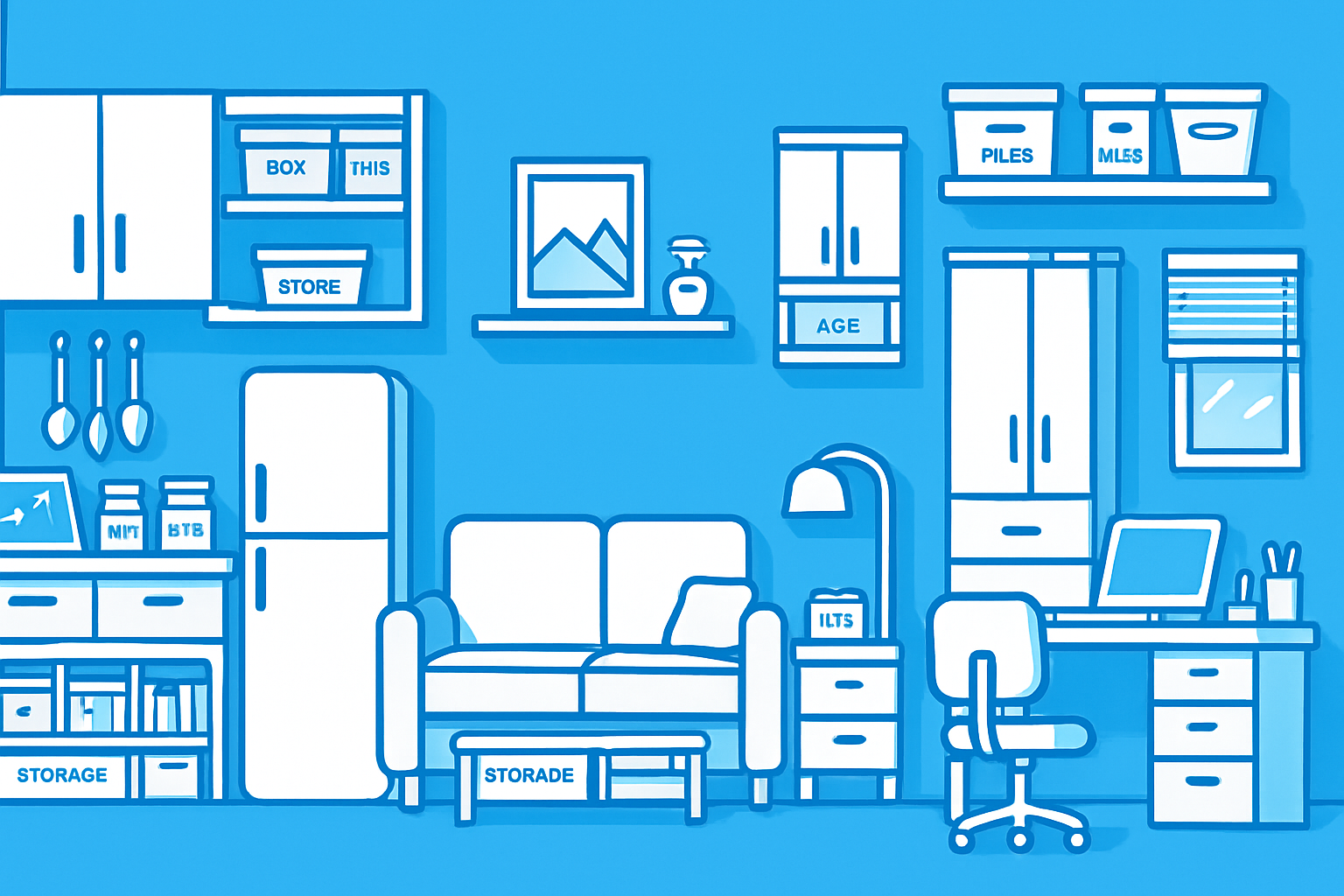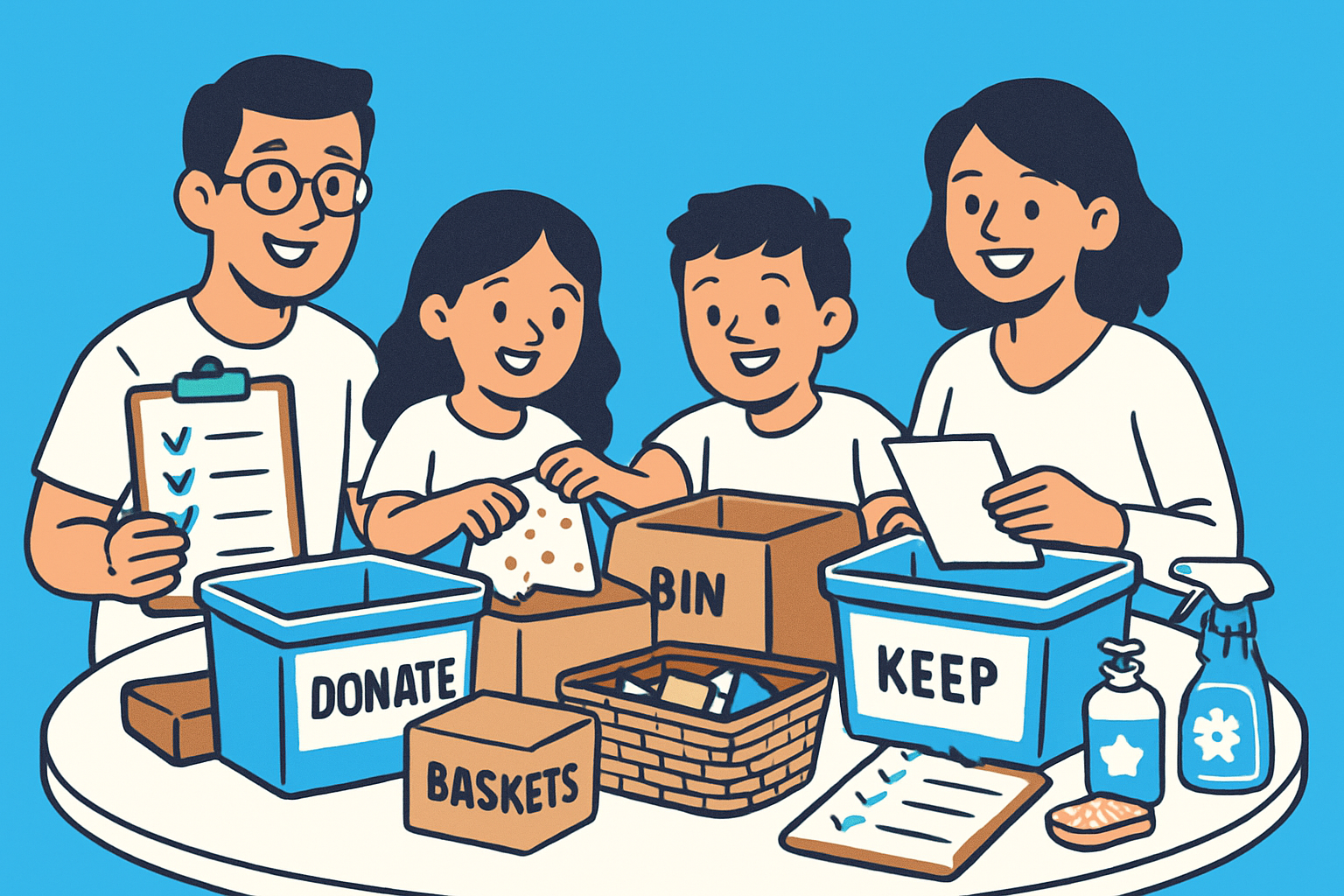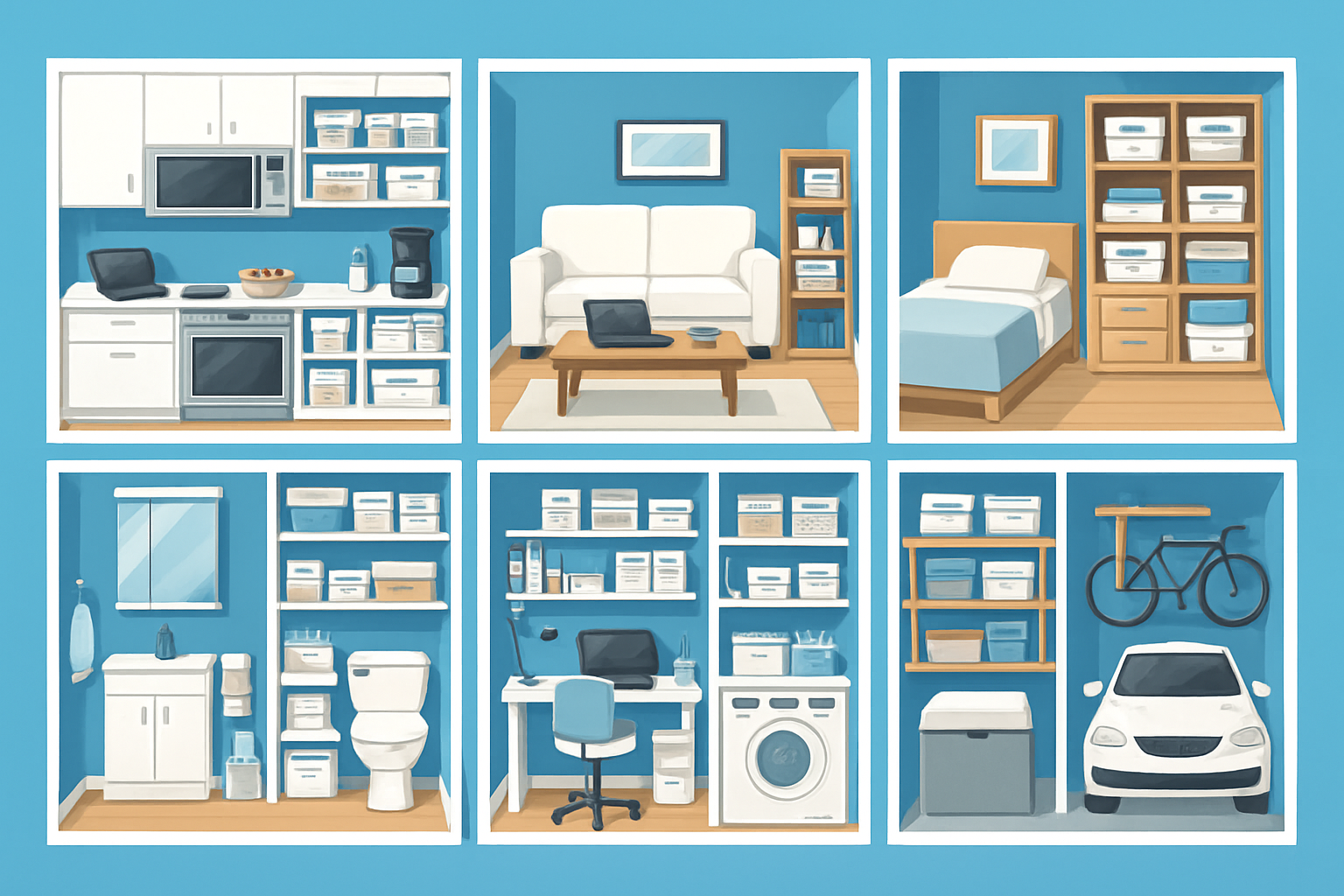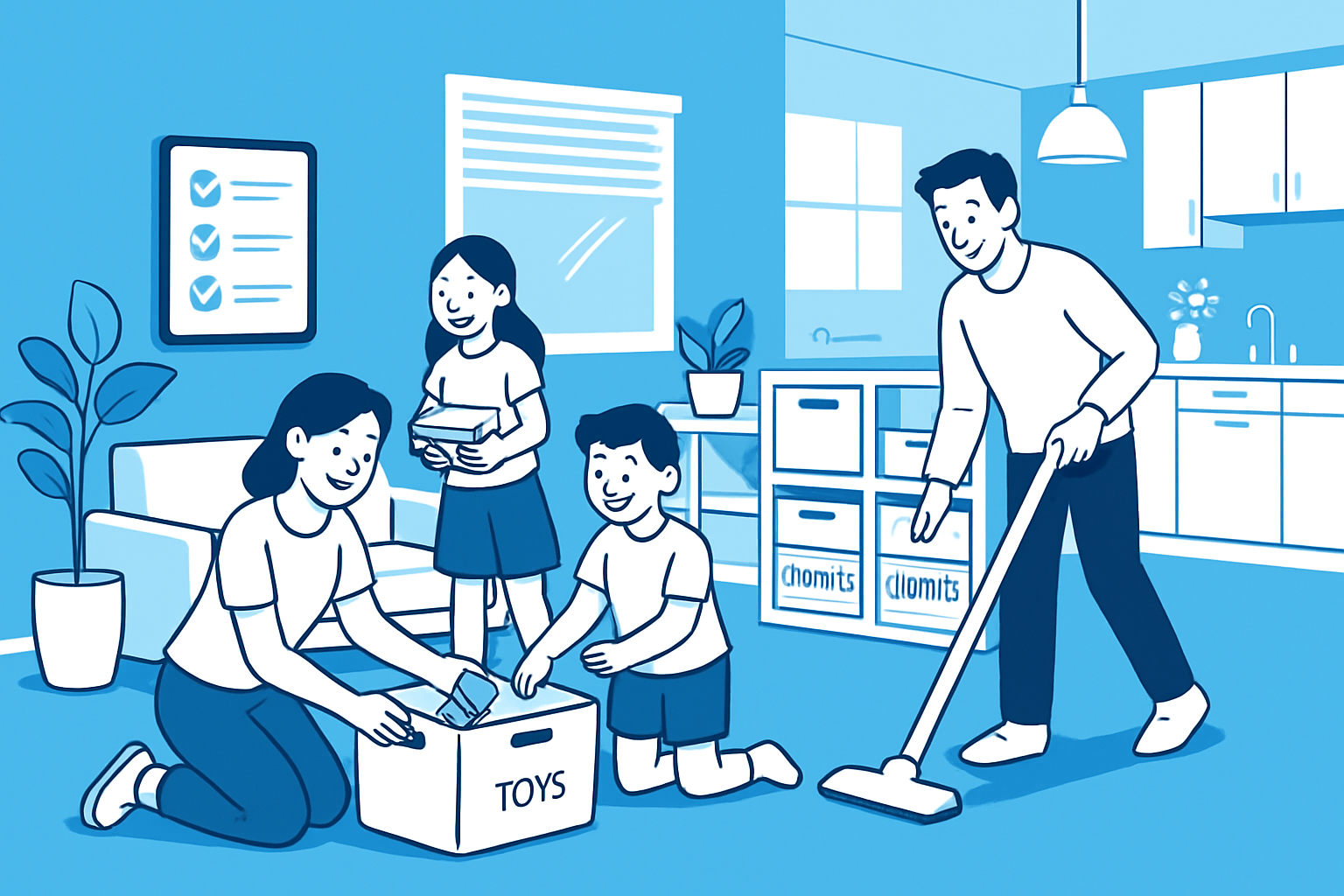Imagine walking into your home and instantly feeling calm, focused, and in control. Every surface is clear, and each item is exactly where it belongs.
In 2025, with busy schedules and evolving lifestyles, keeping things in order is more important than ever. When you organize your home, you set the stage for greater productivity and lasting peace of mind.
This ultimate guide will empower you to transform every corner using proven strategies, room-by-room checklists, and the latest organizing principles. You'll discover practical steps, expert insights, and the best tools to make your home a haven of order and efficiency.
Get ready to learn the core principles of home organization, how to prepare for decluttering, detailed room strategies, maintenance routines, and the top resources to keep your space organized all year.
The Foundations of Home Organization in 2025
Creating a lasting system to organize your home starts with understanding the principles behind modern organization. In 2025, it’s not just about tidying up—it’s about building a lifestyle that supports your well-being, productivity, and peace of mind.

Understanding Modern Organization Principles
Minimalism and intentional living are at the heart of how you organize your home in 2025. Research shows that clutter increases stress levels and impacts productivity, making an organized environment essential for a healthy mind. According to a recent study on clutter and mental health, reducing clutter can significantly improve your mood and focus.
The modern “organization equation” balances time, space, money, and effort for maximum efficiency. Hybrid systems—combining digital apps with physical storage—are on the rise. For example, families who embrace minimalism often report less stress and more time together. In fact, 80% of Americans feel less stressed in an organized home.
The 3 Rs: Reduce, Resourceful, Resilient
To successfully organize your home, start with the 3 Rs. First, reduce your possessions so you’re only keeping what truly serves you. This makes the organizing process faster and more effective. Next, be resourceful by repurposing items you already own—think using old baskets or jars before buying new organizers.
Finally, stay resilient. Life changes, and so should your systems. Sustainable organization means being flexible, not perfect. For instance, limiting kitchenware to essentials streamlines both cooking and cleanup. Remember, the goal is to organize your home in a way that adapts to your real life.
Core Organizing Principles for Every Room
No matter which room you’re tackling, certain principles help organize your home efficiently. Always group similar items together for visibility and easy access. Use the six-month rule: if you haven’t used something in half a year, consider donating or discarding it.
Label everything, but you don’t need fancy gadgets—simple labels work wonders. Assign a specific “home” for each item and make a habit of returning it after use. For example, clear bins and labels in the pantry help avoid food waste and keep everything at your fingertips.
The Psychology of Clutter: Why Things Get Messy
Understanding why clutter happens is key to learning how to organize your home for good. Decision fatigue, emotional attachment, and a lack of simple systems are common culprits. It’s normal for things to look messier before they get neater—embrace the process.
Lasting change comes from shifting your mindset toward progress over perfection. More than half of people say clutter makes them less productive at home, so small steps each day can make a big difference in your journey to organize your home.
Trends and Tools Shaping Organization in 2025
In 2025, organizing trends focus on smart storage, modular furniture, and digital solutions. Many use digital checklists, like Todoist templates, to keep projects on track. Sustainable choices—such as recycled boxes for drawers—are both eco-friendly and budget-conscious.
Online communities and influencers provide daily inspiration and accountability. If you want to organize your home like a pro, look for products and routines that simplify your life, not complicate it. The right tools can turn every space into a functional, stress-free zone.
Preparing for Success: Pre-Organization Steps
Getting ready to organize your home starts long before you open a single drawer. A solid plan keeps you focused, motivated, and less likely to quit halfway. Let’s break down the essential steps for a smooth, stress-free experience.

Scheduling and Planning Your Organizing Project
A successful plan to organize your home begins with realistic scheduling. Instead of trying to tackle everything at once, break your project into smaller, manageable sessions. Block out time on your calendar for each room—maybe a “kitchen day” or a “bedroom weekend”—to keep overwhelm at bay.
Use digital reminders, phone alarms, or printed checklists to stay on track. Involve family members by assigning specific tasks or rooms, and celebrate small wins as you go. This way, you’ll see progress and stay motivated to organize your home from start to finish.
Gathering Supplies and Tools
Before you organize your home, gather all necessary supplies. Stock up on organizers, bins, baskets, cleaning products, and labels. For visibility, clear containers work best, letting you instantly see what’s inside.
- Baskets for grouping items
- Cardboard boxes for budget-friendly sorting
- Labels for quick identification
Choose tools that fit your space and budget. Cardboard boxes can double as temporary organizers if you’re watching costs. Having everything ready means you can organize your home efficiently, without pausing to hunt for supplies.
Declutter Before You Organize
To truly organize your home, decluttering comes first. Start by removing everything from the space you’re working on. Sort items into three piles: keep, donate, or toss. Most people use only 20% of what they own regularly, so don’t be afraid to let go of the excess.
For a step-by-step approach, Decluttering with a Household Organization Binder provides helpful strategies and checklists. Donating unused items before you organize your home makes the process smoother and gives you more breathing room.
Researching Donation and Recycling Options
After sorting, research local donation centers and recycling options to keep your efforts eco-friendly. Many charities accept gently used clothing, linens, and household items. Animal shelters often welcome old towels and bedding.
- Check guidelines for what can be donated or recycled
- Plan donation drop-offs in advance
- Use labeled bags or boxes for easy separation
By planning ahead, you ensure unwanted items don’t linger and clutter returns. This final step helps you organize your home with a sense of accomplishment, knowing you’ve made a positive impact.
Room-by-Room Organization Guide
Ready to organize your home, one space at a time? This detailed guide walks you through every major room, sharing proven steps, smart tips, and real-life examples to help you organize your home with confidence and lasting results.

Kitchen: The Heart of the Home
The kitchen is often the busiest—and messiest—room. To organize your home efficiently, start with a complete audit. Remove everything from the pantry, fridge, and cabinets. Discard expired food, mismatched containers, and anything you no longer use.
Sort items by category: baking supplies, snacks, canned goods, and more. Use clear bins and labels for easy identification. This not only helps you see what you have but also cuts down on food waste. Store frequently used appliances on the counter, while stowing away seldom-used gadgets.
Uniform dishware makes loading and unloading the dishwasher a breeze. Before returning items, wipe down all surfaces and floors. Did you know that, according to Home Organization Statistics 2025, 1 in 3 Americans say the kitchen is their messiest room? When you organize your home starting with the kitchen, you set the tone for the rest of your living spaces.
- Remove everything for a full audit.
- Discard expired or unmatched items.
- Group by category and use clear bins.
- Label shelves and containers.
- Clean all surfaces before putting things back.
A well-organized kitchen makes meal prep faster and clean-up less stressful, helping you organize your home for daily efficiency.
Living Room & Family Room: Creating Calm Spaces
To organize your home for relaxation and togetherness, focus on decluttering the living and family rooms. Start by clearing out old books, magazines, electronics, and random items. Sort everything into keep, donate, or toss piles.
Use baskets, chests, or under-couch storage for blankets and remotes. Hide cords and cables to create a streamlined look. Check your lighting and replace any dead bulbs for a brighter, more inviting space.
Arrange furniture to promote good flow and comfort. A dedicated basket for remotes and chargers can drastically reduce visual clutter. When you organize your home in these shared spaces, you create a more peaceful environment for everyone.
- Declutter surfaces and storage areas.
- Use baskets for small items and blankets.
- Hide unsightly cords and cables.
- Regularly audit decor and accessories.
A calm, organized living room is the perfect place to unwind after a busy day.
Bedroom: Restful and Restorative Retreat
A clutter-free bedroom is essential for restful sleep and peace of mind. Begin by emptying closets, drawers, and under-bed storage. Sort clothes, shoes, and accessories by type and how often you wear them.
Apply the six-month rule: if you haven’t worn something in six months, consider donating it. Use drawer organizers and labeled bins for smaller items like socks and accessories. Store out-of-season clothing separately to free up space.
Under-bed storage is a smart way to maximize every inch. Matching sock colors can make laundry days easier and faster. When you organize your home starting in the bedroom, you build a foundation for better rest and less morning stress.
- Empty all storage spaces for a full reset.
- Sort and donate unused clothing.
- Use labeled bins for accessories.
- Separate seasonal items.
A tidy bedroom helps you organize your home and boost your daily energy.
Bathroom: Streamlined and Sanitary
A well-organized bathroom makes your morning and evening routines seamless. Start by removing all products from cabinets and shelves. Discard expired toiletries, makeup, and medications.
Use acrylic dividers and bins to group items by category—haircare, skincare, and medications. Keep daily essentials accessible, while extras are stored out of sight. Assign a dedicated spot for cleaning supplies and towels.
Labels are your friend: mark bins clearly for each category. When you organize your home’s bathroom, you make it easier for everyone to find what they need and keep the space clean.
- Remove and sort all products.
- Discard expired or unused items.
- Use dividers and bins for organization.
- Label bins for quick access.
A streamlined bathroom is key to maintaining a sanitary and pleasant home.
Home Office: Productivity Powerhouse
If you want to organize your home for maximum productivity, start with the home office. Clear your desk and storage areas completely. Sort paperwork into keep, shred, or file piles.
Organize electronics and accessories in labeled containers. Use vertical storage to save space and keep your workspace clear. A labeled folder for bills and receipts helps you stay on top of finances.
Regular cleaning and decluttering sessions will keep your office organized long term. When you organize your home office, you set yourself up for efficient work and less stress.
- Clear all surfaces and sort paperwork.
- Use labeled containers for electronics.
- Prioritize vertical storage solutions.
- Schedule regular decluttering.
A well-organized office helps you organize your home—and your work life.
Laundry Room & Storage Closets: Order in Utility Spaces
Utility spaces are often overlooked, but organizing them can make daily chores easier. Begin by sorting laundry supplies, towels, and accessories. Discard empty containers and expired products.
Use shelves or baskets to store detergents and softeners. Label storage bins for quick access to essentials. A “lost socks” basket is a simple hack that saves time.
When you organize your home’s laundry and storage areas, you streamline your routines and reduce frustration.
- Sort and discard unnecessary items.
- Use baskets for supplies.
- Label everything for easy retrieval.
- Keep a dedicated “lost socks” container.
Order in utility spaces supports your goal to organize your home everywhere.
Hallways, Garage, and Backyard: Beyond the Main Rooms
Don’t forget the transitional and outdoor spaces when you organize your home. Remove tripping hazards and misplaced items from hallways for better safety and flow.
In the garage, sort tools, paint, and supplies into keep, donate, or toss piles. Pegboards and wall hooks offer vertical storage and keep things off the floor. For the backyard, store outdoor toys and appliances in labeled bins.
Seasonal items should be placed in labeled storage totes for easy access. By organizing these areas, you ensure every part of your home supports a clutter-free lifestyle.
- Clear hallways for safety.
- Sort and store garage tools vertically.
- Use labeled bins for outdoor items.
- Organize seasonal gear in totes.
A truly organized home includes every corner, inside and out.
Maintaining Your Organized Home All Year
Keeping your space in order isn’t a one-time event. To truly organize your home for the long haul, you’ll need to build routines, involve your family, stay flexible, and embrace smart tools. Let’s break down how to make maintenance effortless, so your hard work lasts all year.

Establishing Sustainable Routines
Consistency is the secret to keeping things tidy. Establishing daily, weekly, and monthly routines ensures you continually organize your home without feeling overwhelmed. Start small with daily habits like returning items to their designated spots and a quick evening reset.
Try a simple checklist to keep your system running smoothly:
- Make the bed every morning
- Sort mail and paperwork daily
- Tidy living areas each night
- Deep clean and organize weekly
- Audit storage spaces monthly
For even more structure, explore the Home Organization System Guide for proven routines that fit every lifestyle. With reliable habits, you’ll maintain order with minimal effort.
Involving the Whole Family
Organization thrives when everyone participates. Assigning age-appropriate tasks helps distribute the workload and teaches responsibility. Use visual chore charts or checklists to make expectations clear and foster teamwork as you organize your home together.
Task assignment ideas:
| Family Member | Task Example |
|---|---|
| Kids | Sort toys into bins |
| Teens | Manage laundry baskets |
| Adults | Handle paperwork |
Encourage the “one in, one out” rule for new items. When everyone pitches in, maintaining a clutter-free environment becomes second nature.
Adapting Systems as Life Changes
Life is full of changes—new family members, shifting schedules, or new hobbies. The key to sustaining success as you organize your home is resilience and flexibility. Regularly review your systems and adjust as needed.
Repurpose storage bins for different uses as your needs evolve. Update labels and rearrange spaces to reflect current routines. Remember, a perfect system isn’t the goal; adaptability ensures your home stays organized through every season of life.
Digital Tools and Smart Solutions for 2025
Embrace technology to help organize your home and keep it that way all year. Use digital calendars, reminders, and home management apps to track tasks and cleaning schedules. Smart storage solutions, like modular furniture and app-controlled organizers, make maintaining order even easier.
For templates, printables, and digital checklists, check out Stay Organized with a Home Management Binder to streamline your routines. Studies show digital reminders boost task completion, so let your devices do some of the heavy lifting.
Must-Have Tools and Resources for Home Organization
Ready to organize your home like a pro in 2025? The right tools and resources make all the difference between a cluttered space and a streamlined sanctuary. As the demand for organized living rises—fueled by a growing market and new innovations—choosing the best products and strategies will help you stay ahead of the curve. Let’s explore the essentials that will empower you to organize your home and keep it that way all year.
Essential Organizing Products for Every Room
To effectively organize your home, start with versatile products that suit every space. Clear bins and baskets let you see what’s inside at a glance, reducing time spent searching for items. Stackable containers help you maximize vertical storage, especially in small rooms.
Drawer dividers keep clothing, office supplies, or toiletries neatly separated. Modular shelving systems adapt as your needs change, making it simple to reconfigure storage when life evolves. If labeling is your style, label makers and budget-friendly stickers ensure every item has a designated spot.
- Clear bins for pantry, bathroom, or closet
- Stackable containers for fridge or storage rooms
- Drawer dividers for bedrooms and offices
- Modular shelves for living rooms or garages
- Over-the-door organizers for bathrooms or entryways
When you organize your home with these products, you create order that’s easy to maintain.
Digital Organization Tools and Templates
In 2025, digital tools are game-changers for anyone looking to organize your home efficiently. Task manager apps like Todoist let you break down big projects into manageable steps and set reminders for routine tasks. Downloadable checklists and printable organizing templates help keep everyone on track, whether you prefer digital or paper systems.
Cloud storage is another must-have, making it simple to keep important documents and home inventories accessible and secure. For families, a shared digital calendar ensures cleaning schedules and organizing days don’t get forgotten.
| Tool Type | Example Use |
|---|---|
| Task Manager App | Schedule declutter sessions |
| Printable Checklist | Track pantry or closet organization |
| Shared Calendar | Assign family chores |
| Cloud Storage | Home inventory and receipts |
With the right tech, you can organize your home and stay on top of tasks effortlessly.
Sustainable and Budget-Friendly Organizing Solutions
You don’t have to spend a fortune to organize your home. Repurposing boxes, jars, and containers you already own is both eco-friendly and cost-effective. Shop secondhand for baskets or shelves, or try simple DIY hacks to create custom storage.
For example, old shoe boxes make excellent drawer dividers, while glass jars corral office supplies or bathroom essentials. If you’re on a tight budget, cardboard boxes work as temporary organizers until you find permanent solutions.
- Repurpose containers for storage
- Shop thrift stores for baskets and bins
- Use jars for pens, clips, or makeup
- DIY drawer dividers from shoe boxes
- Temporary storage with labeled cardboard boxes
These strategies help you organize your home without breaking the bank.
Expert Tips and Community Support
Sometimes, the best way to organize your home is by learning from others who have mastered the art. Home organization influencers offer daily inspiration, while online communities provide accountability, advice, and motivation. Expert guides and webinars dive deep into advanced strategies, perfect for tackling tricky spaces.
Joining a “30-day declutter challenge” group can kickstart your journey, and setting up a family command center is a proven way to keep everyone organized. For a step-by-step approach, check out The Ultimate Guide to Creating the Perfect Family Command Center for actionable ideas.
By tapping into these resources, you’ll find fresh ways to organize your home and get support when you need it most.
Staying Motivated and Tracking Progress
Staying motivated is key if you want to organize your home and keep it that way. Set realistic goals for each room, and celebrate small wins—like a clutter-free drawer or an organized closet. Use visual progress trackers such as before-and-after photos or checklists to see how far you’ve come.
Reward yourself or your family for maintaining organization, even if it’s just with a fun movie night or a special treat. Monthly “organization reviews” give everyone a chance to check in, adjust systems, and stay accountable.
By regularly tracking your achievements, you’ll keep up the momentum and continue to organize your home with confidence.
If you’re ready to turn all these organizing tips into real, lasting change, I’ve got a tool that makes it so much easier. Imagine having every piece of your family’s important info—finances, home details, insurance, even your kids’ and pets’ needs—all in one spot, organized and secure. That peace of mind is exactly what The Family Binder offers. It’s printable, editable, and designed to help you keep your home and life running smoothly, no matter what 2025 brings. Ready to get started? Download Now and take the next step toward an organized, stress-free home!

